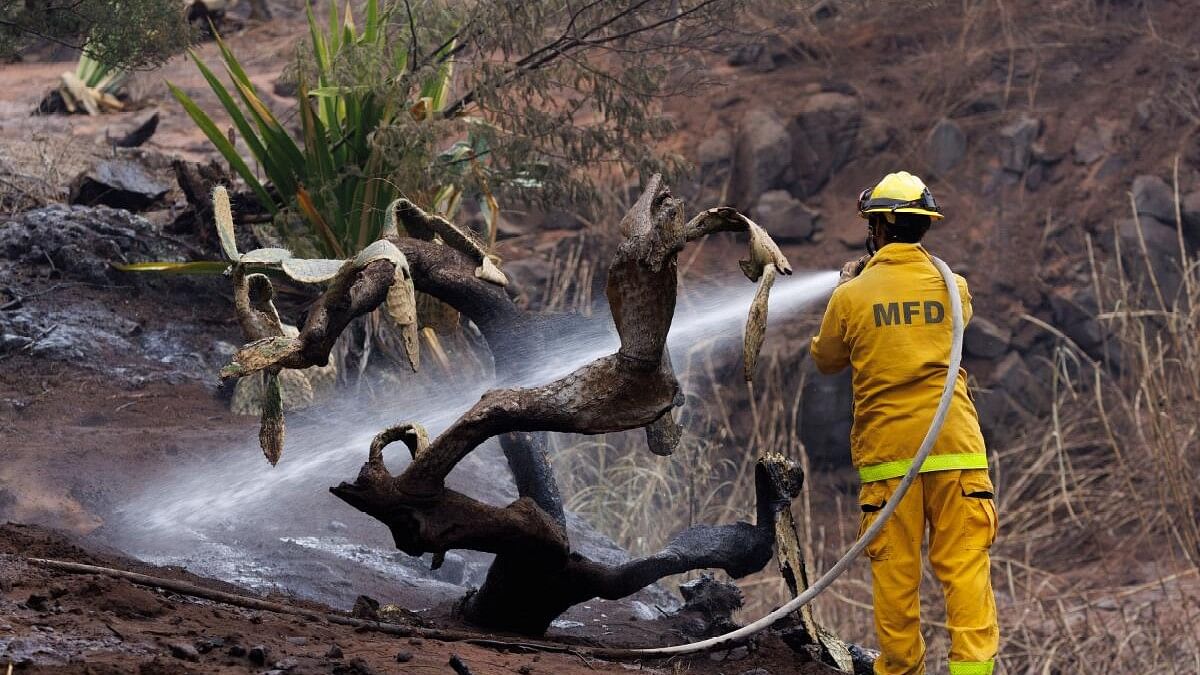
The death toll from the Maui wildfires reached 93 on Sunday as relatives of the missing frantically searched for signs their loved ones may still be alive.
Hawaii Governor Josh Green on Sunday likened the burnt-out city of Lahaina to a "war zone" after the fast-moving blaze engulfed the northwest coast of Maui on Tuesday, leveling much of the historic resort town and scorching nearly everything in its path.
Days after the inferno, crews of firefighters were still battling flare-ups, and cadaver dogs were sifting through the town's charred ruins in search of victims as survivors and officials grappled with the scale of the disaster.
"Right now, we are still in the throes of the acute phase of this recovery, meaning that we're still recovering the tragic loss of life," Green told MSNBC on Sunday. "We're at 93 (victims) now ... it's a war zone, but the help is incredible."
Green again vowed to investigate the response to the blaze and the emergency notification systems after some residents questioned whether more could have been done to warn them.
Some witnesses said they had little warning, describing their terror as the blaze destroyed the town around them in what seemed to be a matter of minutes. Others dove into the Pacific Ocean to escape.
Sirens stationed around the island, intended to warn of impending natural disasters, never sounded, and widespread power and cellular outages hampered other forms of alerts.
"We'll know soon whether or not they did enough to get those sirens going," Green said in the TV interview.
President Joe Biden on Sunday told reporters asking whether he planned to visit Maui in the coming days, "we're looking into it." While sometimes uplifting to the victims, presidential visits place a burden on recovery efforts with their logistical and security needs.
The death toll made the blaze Hawaii's worst natural disaster, surpassing a tsunami that killed 61 people in 1960, a year after Hawaii became a U.S. state.
The death toll also exceeded that of the 2018 fire in the town of Paradise, California, in which 86 people perished, and was the highest from a U.S. wildfire since 1918, when 453 people died in the Cloquet fire in Minnesota and Wisconsin, according to data from the National Fire Protection Association.
Officials have secured 1,000 hotel rooms for people who lost their homes and are arranging for rental properties to serve as housing at no cost to families, Green said on Saturday. More than 1,400 people had been taken in at emergency shelters.
People sifted through a crowd-sourced online database listing thousands of names of individuals who had been found as well as of those who remained unaccounted for.
Family and friends mobilized on social media, sharing information about their missing loved ones, asking for help in locating them.
"Still searching for my in-laws," Heather Baylosis wrote in a Saturday Instagram post. "People are being found alive and severely disoriented due to what they have gone through. We are holding out hope!"
Megan Sweeting wrote on her Facebook page, "MISSING: My Dad, Michael Misaka, has been missing since the Lahaina Fires started. If there is any information out there regarding my dad please let me know. I just need to know he is safe."
Hundreds of people were still missing, though a precise count was not clear.
Officials began allowing residents back into west Maui on Friday, although the fire zone in Lahaina remained barricaded. The governor said the area is a hazardous site due to dangerous fumes from the smoldering ruins.
The cost to rebuild Lahaina was estimated at $5.5 billion, according to the Federal Emergency Management Agency (FEMA), with more than 2,200 structures damaged or destroyed and more than 2,100 acres (850 hectares) burned.
FEMA said more than 250 staff have been deployed including 45 disaster survivor assistance specialists who are visiting shelters in Maui to help people register for aid.